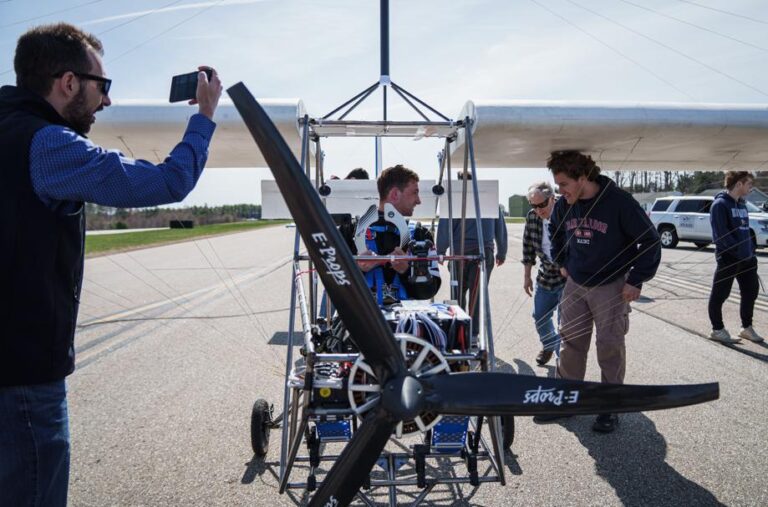Marcus Herold grew up with airplanes overhead, living near the flight path of the Manchester, N.H., airport.
Now, he’s graduated from the remote-controlled airplanes he built as a boy to the real thing. Along with four other University of New Hampshire students, Herold designed and built an electric ultralight plane that successfully took flight this spring.
“I’ve been dreaming of building my own plane for a long time,’’ he said. “It felt kind of surreal, being there and watching it’’ fly.
The students and their faculty adviser, Ivaylo Nedyalkov, senior lecturer in mechanical engineering, were unaware of any other undergraduates to accomplish such a feat.
“I had seen some people build electric ultralights before, and I knew it was possible,’’ said Herold, the team lead. “But nobody’s ever done something quite so ambitious for a senior project.’’
The flight at Skyhaven Airport in Rochester, N.H., lasted about 10 to 15 seconds, according to the pilot, Zachary Yeaton, a junior in the mechanical engineering program at UNH who obtained a pilot’s license at 18.
“I took her down the runway, and she just leaped up in the air,’’ he said of the plane. “It was an amazing feel and experience. I was happy that I could be the one to pilot it for them.’’
Was he nervous to fly his classmates’ creation? No, Yeaton insists, he had complete confidence in their diligent work. But, he admitted, he wasn’t sure his parents would agree: He said he didn’t tell them about the flight until it was over.
Leading up to that moment, the students estimated that they collectively logged about 6,000 hours working to design and build the aircraft, with members putting in between 30 to 50 hours per week. They had to prove their concept by building a quarter-scale model in the spring of their junior year. Then, they had to keep the plane’s weight under 254 pounds in order to qualify as an ultralight aircraft.
The team members developed expertise in different areas, from computational simulations to using a 3D printer to fabricate airplane parts, according to Herold, who helped assemble the team.
“I knew everyone had the guts to learn these new things and push themselves to understand it better,’’ he said.
Another challenge was getting approval to actually fly the machine they had built, according to Ethan Tillinghast, a UNH senior on the team who was responsible for obtaining the legal clearance. Tillinghast said they had outside experts evaluate their work, which bolstered their case.
“That was months of contacting legal and showing proof of concept, showing all of our design and all of our testing, our analysis. Everything on paper that we’ve done shows it’s going to work,’’ he said.
Still, there were some nerves on the day of the flight.
“I was definitely very stressed out before the flight,’’ said Seth Chartier, a senior. “I had designed the landing gear, and I was very worried about it breaking upon landing.’’
Thankfully, the landing gear held strong, and the other components of the plane performed as the team had hoped on their first try.
“This team has set the bar exceptionally high,’’ said their adviser, Nedyalkov. “They’ve shown that with the right mix of vision, drive, discipline, and teamwork, students can take on challenges that many would consider out of reach.’’
While it was the first plane he built, Herold is hoping it won’t be his last.
After graduation this month, he plans to continue studying aerospace engineering at UNH through a master’s program. He said his dream job is working for Beta Technologies, a company that builds electric aircraft based in South Burlington, Vt.
Amanda Gokee can be reached at amanda.gokee@globe.com. Follow her @amanda_gokee.

